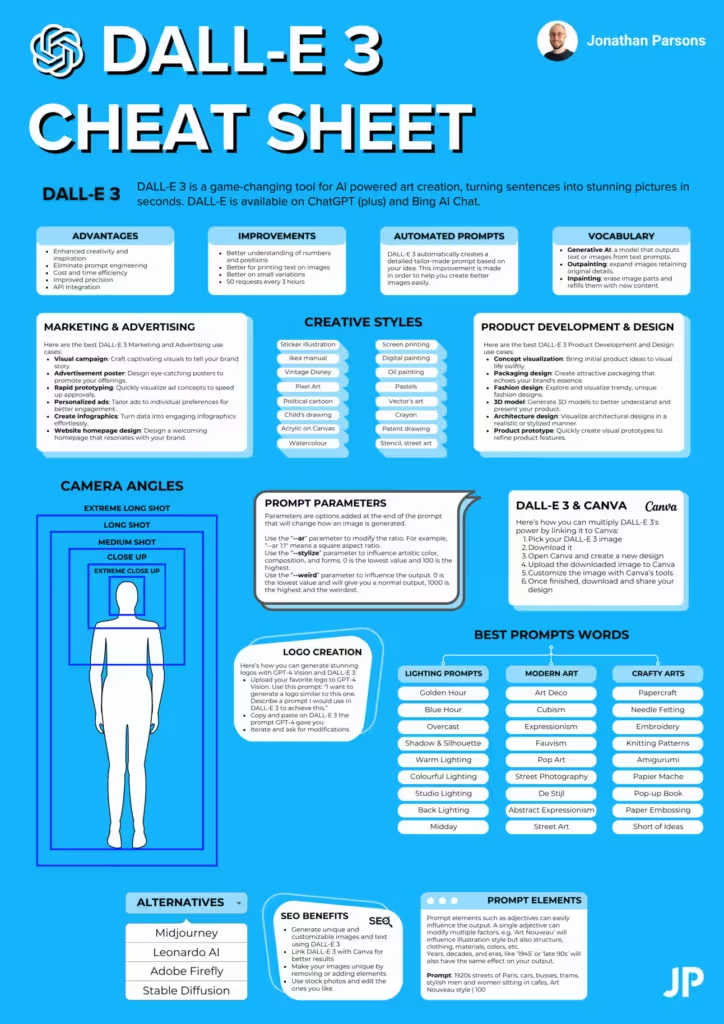Mastering Prompt Engineering for DALL·E 3: A Deep Dive into Generating High-Quality Visuals
With the rapid advancements in AI image generation, DALL·E 3 from OpenAI has emerged as a powerful tool for generating highly detailed and creative visual content from text prompts. However, as with any tool, the quality of the output largely depends on how effectively the user interacts with it, particularly through prompt engineering. This guide dives into the intricacies of how you can prompt-engineer to maximize the results when using DALL·E 3.
1. Understand the Power of Specificity
One of the most crucial aspects of generating high-quality images is to be as specific as possible in your prompts. Vague prompts will often yield generic results, while detailed, well-thought-out prompts will guide DALL·E 3 to create more accurate representations.
- Example: Instead of saying “a cat,” say “a fluffy white Persian cat with blue eyes, sitting on a Victorian-style armchair.”
This level of specificity provides DALL·E 3 with a clear understanding of the subject matter, desired aesthetic, and the scene’s setting, allowing it to produce more nuanced and detailed visuals.
2. Use Adjectives to Define Style and Mood
Visual prompts are enhanced when you include descriptive language that conveys style, mood, and artistic direction. Words like “vintage,” “surreal,” “ethereal,” or “cinematic” help DALL·E interpret the visual atmosphere you want the image to convey.
- Example: “A surreal scene of floating islands in a pastel sky with ethereal lighting.”
Here, terms like “surreal,” “pastel,” and “ethereal” shape the overall feeling and color palette, guiding DALL·E to adopt a specific style that matches the user’s vision.
3. Incorporate Specific Visual Elements
When generating images, think about every element you want included in the composition. These might be objects, colors, textures, or even the positioning of elements within the scene.
- Example: “A futuristic cityscape at sunset, with neon lights reflecting off the glass skyscrapers and flying cars in the sky.”
In this case, the prompt details not only the scene (cityscape) but also includes temporal elements (sunset), materials (glass), lighting effects (neon reflections), and specific objects (flying cars).
4. Consider Art and Historical References
DALL·E 3 has been trained on a wide variety of images, including those from art history and different visual cultures. By referencing specific artistic movements, historical periods, or styles, you can prompt DALL·E to create images that reflect those influences.
- Example: “A Renaissance-style painting of a knight on horseback, with Baroque lighting and intricate armor detailing.”
By referencing “Renaissance” and “Baroque,” you’re drawing on distinct art periods known for their lighting, composition, and detailing, steering DALL·E toward a specific aesthetic.
5. Leverage Composition Directives
When thinking about how you want your image to appear, consider providing instructions on the composition and layout of the scene. This can include positioning (foreground, background), focal points, angles, or even perspective.
- Example: “A bird’s-eye view of a forest with a winding river cutting through it, under a cloudy sky.”
This prompt gives a clear directive about the perspective (bird’s-eye view) and key elements (river, forest, sky), ensuring DALL·E composes the scene appropriately.
6. Experiment with Color and Lighting
Color and lighting play a vital role in the mood of an image. By specifying the desired lighting conditions or color schemes, you can dramatically influence the aesthetic quality of the output.
- Example: “A portrait of a woman in soft, golden hour lighting with warm, earthy tones.”
Here, the mention of “golden hour lighting” immediately evokes a specific time of day known for its warm, soft glow, and “earthy tones” helps guide the color palette.
7. Utilize Emotion and Expression
AI-generated images are not just about depicting objects; they can also convey emotional depth and expression, particularly in portraits or character designs. This emotional resonance is achieved through intricate algorithms that analyze human expressions and cultural nuances, allowing the AI to mimic the subtleties of real-life emotions. As the spectrum of artificial intelligence explained shows, these advancements not only enhance the creativity of digital art but also push the boundaries of what machines can understand about the human experience. Consequently, artists and creators are increasingly leveraging these technologies to explore new dimensions of storytelling and connection within their work.
- Example: “A digital portrait of a man in his 50s, with a solemn expression, gazing into the distance, with melancholy lighting.”
In this prompt, words like “solemn expression” and “melancholy lighting” shape not only the visual details but also the emotional tone of the image.
8. Avoid Overly Complex or Contradictory Prompts
While detail is important, overly complex prompts or those containing conflicting directives can confuse DALL·E, resulting in subpar or incoherent images.
- Example of a Contradictory Prompt: “A sunny beach scene at night, with dark shadows and bright colors.”
This prompt mixes elements that are hard to reconcile (a beach scene both sunny and at night). Try to maintain logical consistency within your prompts to avoid confusing the model.
9. Use Iteration and Refinement
Prompt engineering is often an iterative process. After receiving an image, you might find areas for improvement. Refine your prompt based on what you see, providing clearer or more detailed instructions on the next iteration.
- Example: If the image lacks the desired detail, you can add: “Increase the level of detail on the subject’s face and make the background slightly blurred for depth of field.”
Iterating this way helps you hone in on the exact result you’re looking for.
Maximizing Creativity with DALL·E 3
The beauty of DALL·E 3 is its ability to generate images that would be nearly impossible to achieve without advanced artistic skills. However, its results are directly proportional to the clarity, creativity, and thoughtfulness of the prompts you feed it.
By practicing with different levels of specificity, incorporating mood, and ensuring that composition, color, and lighting are detailed, you can unlock truly astonishing results. And remember, while DALL·E 3 is an incredible tool, it shines brightest when users provide well-crafted prompts that push the boundaries of creativity.








